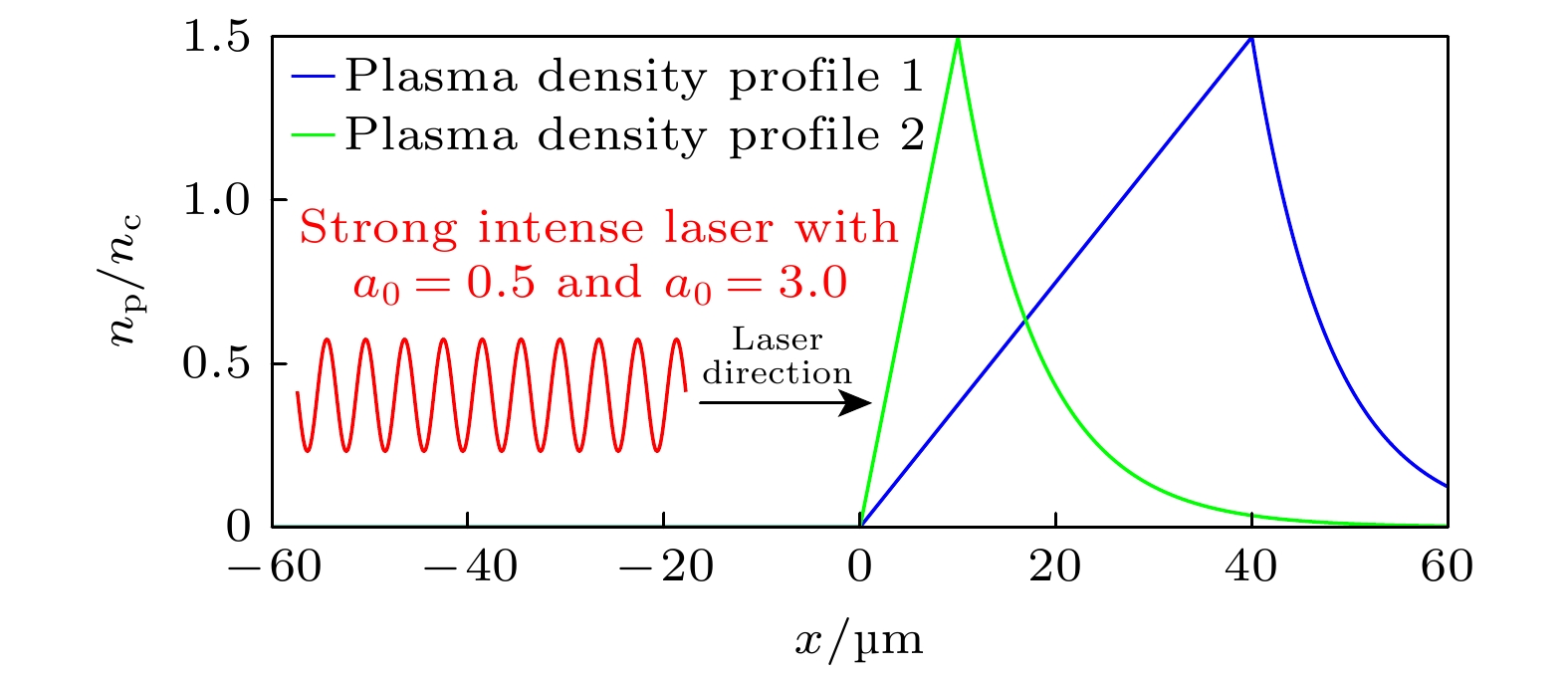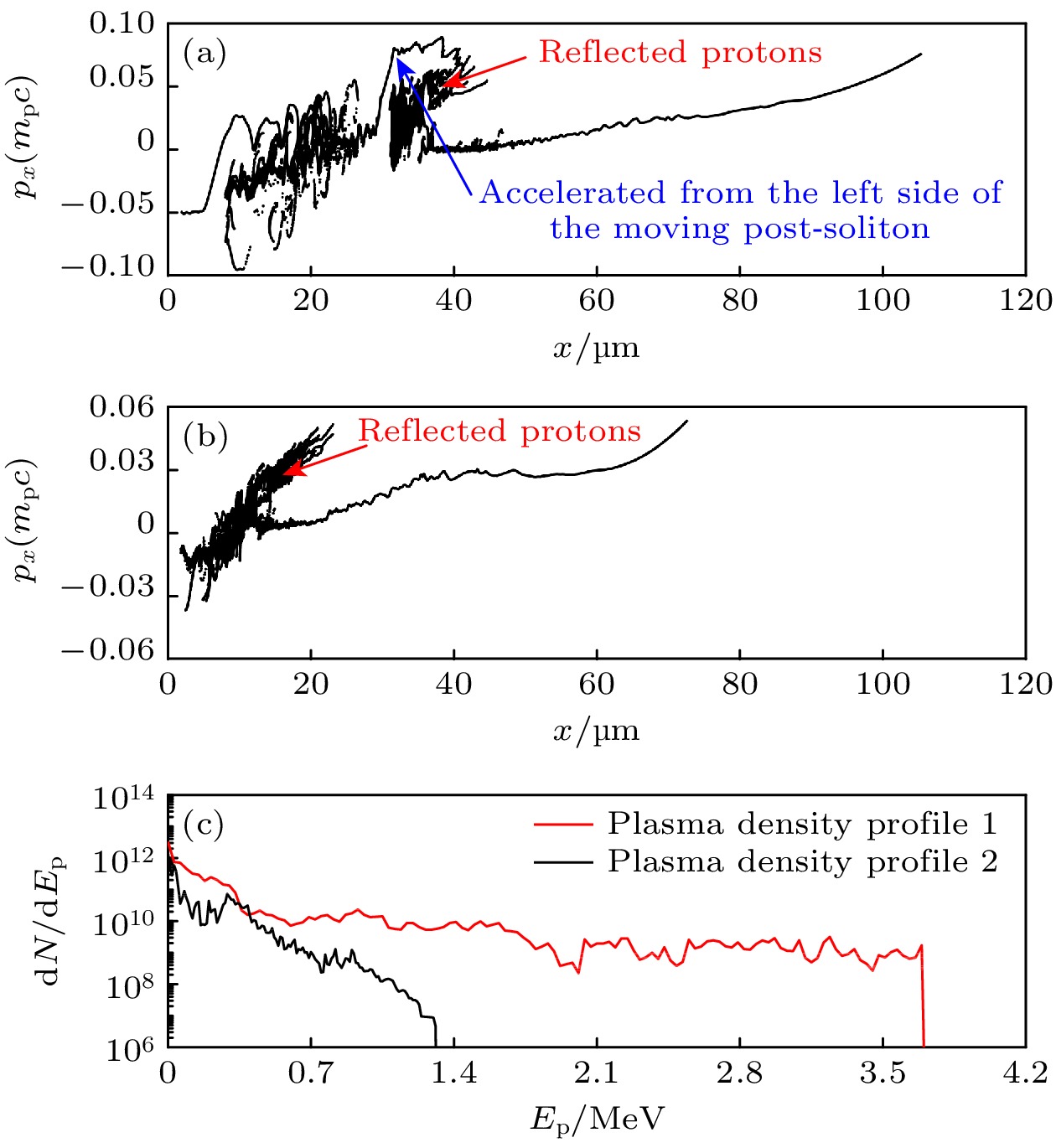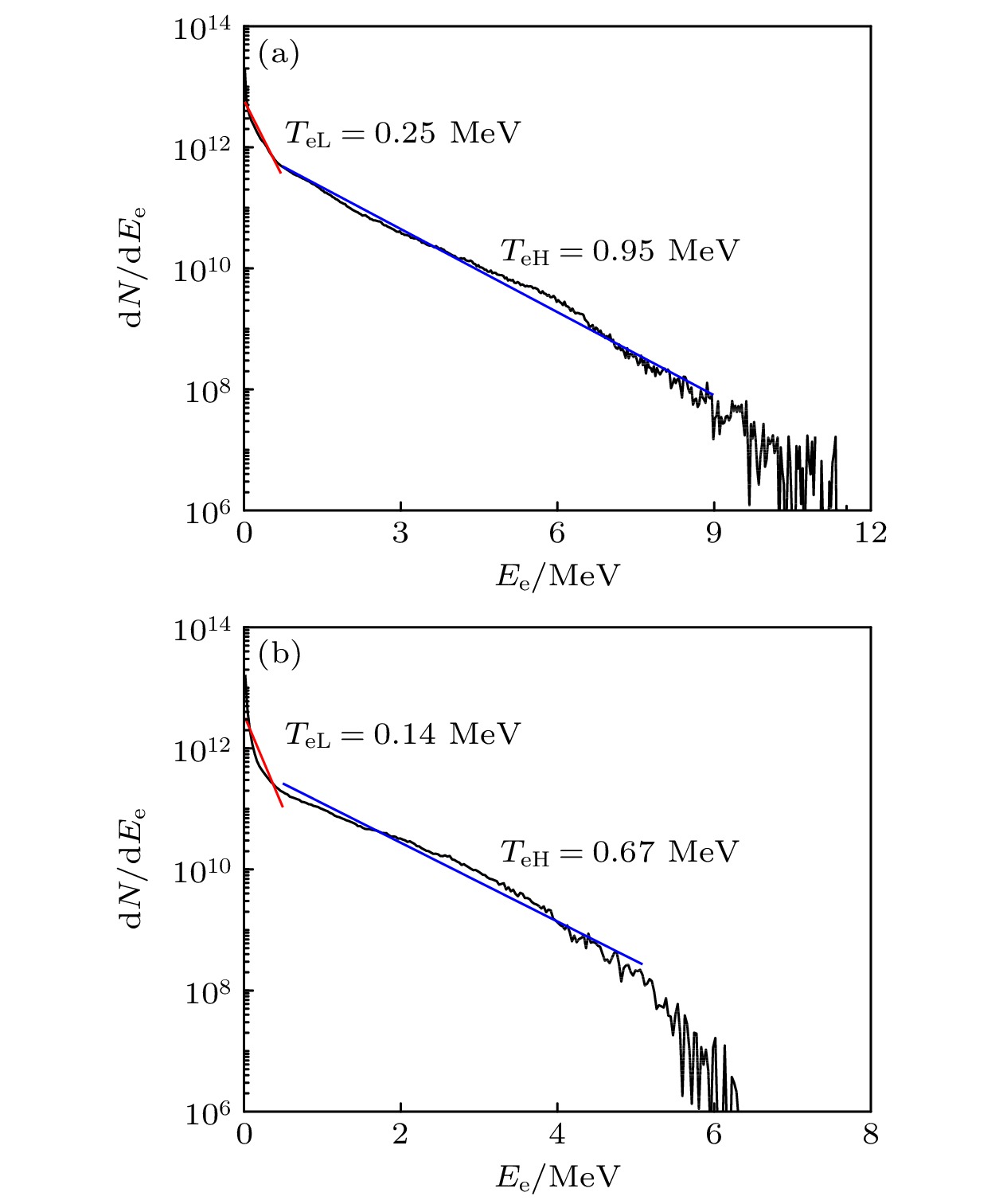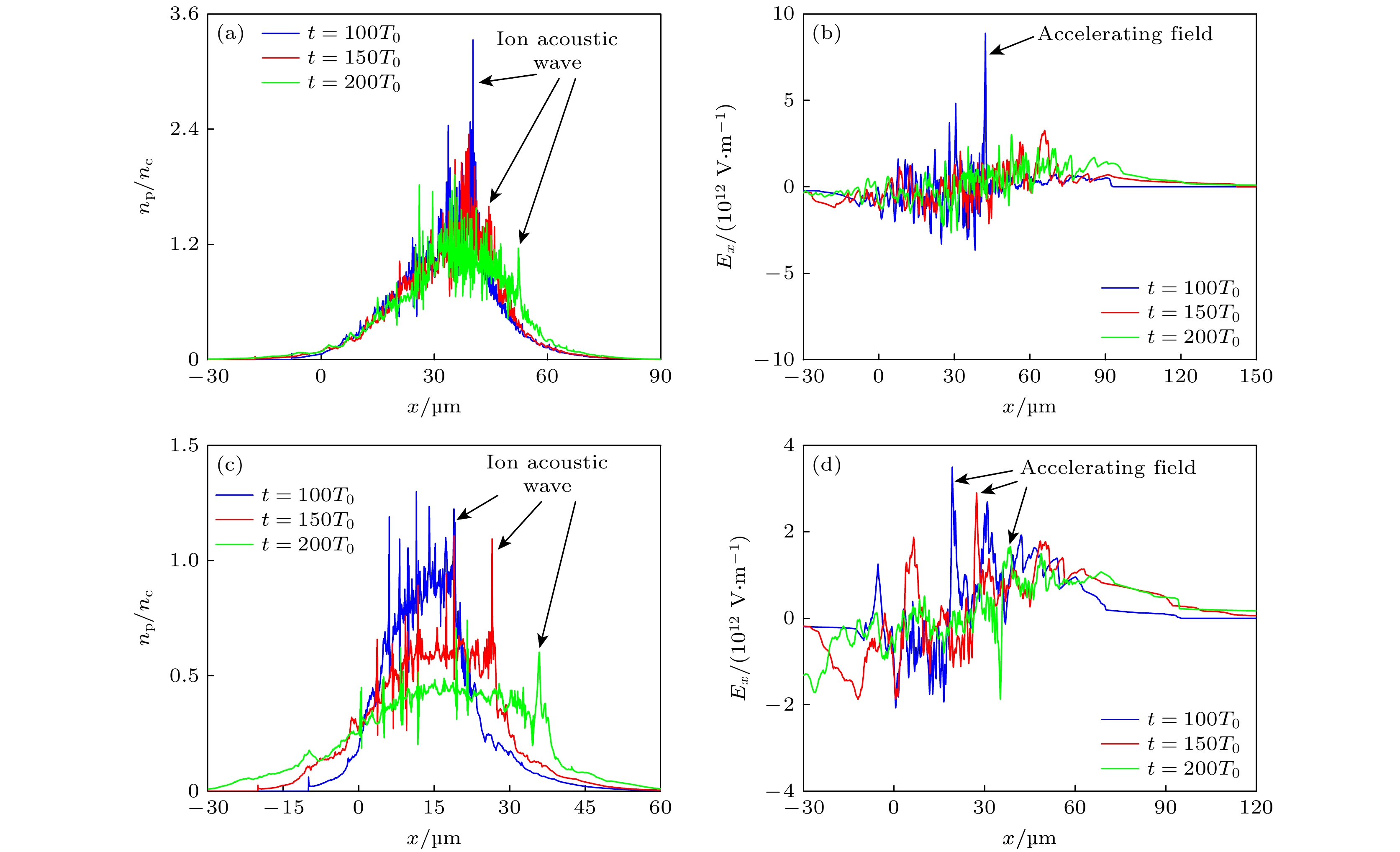-
本文通过一维粒子模拟(particle-in-cell)方法研究了强激光与近临界密度等离子体相互作用中的弱冲击波和强冲击波产生, 并讨论了非相对论和相对论光强以及等离子体密度分布区间对无碰撞冲击波形成的影响. 非相对论的弱驱动光与等离子体相互作用产生的是弱冲击波. 由于电子加热不充分, 电子能谱呈现出双温分布. 较低温度的电子对弱冲击波的形成以及质子反射加速有重要作用. 弱冲击波加速质子的能谱呈连续分布. 在等离子体密度上升沿区间较大时, 可观察到后孤子结构向离子声波结构演化并进一步演化为弱冲击波结构的过程. 在相对论的强驱动光强下, 电子加热比较充分可达到相对论温度, 且呈现出单温分布. 进一步分析密度分布区间大小对冲击波形成的影响时发现: 1) 当等离子体密度上升沿区间较大时, 离子声波的势垒易被热电子屏蔽且离子声波结构在传输的过程中容易被后续的激光破坏而无法演化为无碰撞冲击波; 2) 当等离子密度分布区间较小时, 离子声波中加速电场的有效距离(即德拜长度)和持续时间更长, 这导致其结构在传输过程中更加稳定. 当离子声波中加速的质子与靶后鞘层场加速的质子之间的速度差满足无碰撞冲击波的离子反射条件时, 离子声波进一步演化为强的无碰撞冲击波, 同时产生了准单能的质子.Weak and strong collisionless electrostatic shock wave (CESW) generated in the interaction between strong intense laser and near-critical-density plasma are studied by the one-dimensional particle-in-cell simulation in this work. And the effects of the ranges of plasma density profiles, non-relativistic and relativistic laser intensities on the generation of CESWs are also investigated. The non-relativistic weakly driven laser generates the weak CESW in the interaction between the laser and near-critical-density plasma. The electron spectra show double-temperature distribution because the non-relativistic driven laser cannot heat the electrons sufficiently. The low-temperature electrons have an important influence on the generation of weak CESW, and they can also cause the protons to be accelerated and reflected from the CESWs. The spectra of the weak CESW protons show a continuously distributed profile. When the range of plasma density up-ramp is large, the process can be observed that the post-soliton structure evolves into the ion acoustic wave and further into the weak collisionless electrostatic shock wave. When the driven laser intensity is relativistic, the electrons are heated sufficiently to a single relativistic temperature. The effect of the range of plasma density profile on the generation of CESW is further analyzed and it is found that 1) when the range of plasma density up-ramp is large, the potential barrier of ion acoustic wave is shielded by the hot electrons; 2) when the range of plasma density up-ramp is small, the effective distance (i.e. the Debye length) of accelerating field is larger and the endurance time is longer than when the range of plasma density up-ramp is large. This makes the ion acoustic wave structure more stable in its forward propagation process. When the difference in velocity between the ion acoustic wave accelerating protons and the target normal sheath accelerating protons satisfies the proton reflection condition of CESW, the ion acoustic wave further evolves into the strong CESW, the monoenergetic protons generated at the same time.
-
Keywords:
- strong intense laser /
- collisionless electrostatic shock waves /
- electron temperature /
- ion acoustic wave
[1] Moiseev S S, Sagdeev R Z 1963 J. Nucl. Energy, Part C Plasma Phys. 5 43
 Google Scholar
Google Scholar
[2] Taylor R J, Baker D R, Ikezi H 1970 Phys. Rev. Lett. 24 206
 Google Scholar
Google Scholar
[3] Ghavamian P, Schwartz S J, Mitchell J, Masters A, Laming J M 2013 Space Sci. Rev. 178 633
 Google Scholar
Google Scholar
[4] Waxman E 2006 Plasma Phys. Control. Fusion 48 B137
 Google Scholar
Google Scholar
[5] Nishikawa K -I, Hardee P, Richardson G, Preece R, Sol H, Fishman G J 2003 Astrophys. J. 595 555
 Google Scholar
Google Scholar
[6] Huang J, Weng S M, Wang X, Zhong J Y, Zhu X L, Li X F, Chen M, Masakatsu M, Sheng Z M 2022 Astrophys. J. 931 36
 Google Scholar
Google Scholar
[7] Drake R P 2000 Phys. Plasmas 7 4690
 Google Scholar
Google Scholar
[8] Courtois C, Grundy R A D, Ash A D, Chambers D M, Woolsey N C, Dendy R O, McClements K G 2004 Phys. Plasmas 11 3386
 Google Scholar
Google Scholar
[9] Romagnani L, Bulanov S V, Borghesi M, Audebert P, Gauthier J C, Löwenbrück K, Mackinnon A J, Patel P, Pretzler G, Toncian T, Willi O 2008 Phys. Rev. Lett. 101 025004
 Google Scholar
Google Scholar
[10] Denavit J 1992 Phys. Rev. Lett. 69 3052
 Google Scholar
Google Scholar
[11] Silva L O, Marti M, Davies J R, Fonseca R A, Ren C, Tsung F S, Mori W B 2004 Phys. Rev. Lett. 92 015002
 Google Scholar
Google Scholar
[12] Chen M, Sheng Z M, Dong Q L, He M Q, Li Y T, Bari M A, Zhang J 2007 Phys. Plasmas 14 053102
 Google Scholar
Google Scholar
[13] Liu M, Weng S M, Li Y T, Yuan D W, Chen M, Mulser P, Sheng Z M, Murakami M, Yu L L, Zheng X L, Zhang J 2016 Phys. Plasmas 23 113103
 Google Scholar
Google Scholar
[14] Fiuza F, Stockem A, Boella E, Fonseca R A, Silva L O, Haberberger D, Tochitsky S, Gong C, Mori W B, Joshi C 2012 Phys. Rev. Lett. 109 215001
 Google Scholar
Google Scholar
[15] Zhang W L, Qiao B, Huang T W, X. F. Shen, W. Y. You, X. Q. Yan, S. Z. Wu, Zhou C T, He X T 2016 Phys. Plasmas 23 073118
 Google Scholar
Google Scholar
[16] Zhang W L, Qiao B, Shen X F, You W Y, Huang T W, Yan X Q, Wu S Z, Zhou C T, He X T 2016 New J. Phys. 18 093029
 Google Scholar
Google Scholar
[17] Haberberger D, Tochitsky S, Fiuza F, Gong C, Fonseca R A, Silva L O, Mori W B, Joshi C 2012 Nat. Phys. 8 95
 Google Scholar
Google Scholar
[18] Zhang H, Shen B F, Wang W P, Zhai S H, Li S S, Lu X M, Li J F, Xu R J, Wang X L, Liang X Y, Leng Y X, Li R X, Xu Z Z 2017 Phys. Rev. Lett. 119 164801
 Google Scholar
Google Scholar
[19] Dover N P, Cook N, Tresca O, Ettlinger O, Maharjan C, Polyanskiy M N, Shkolnikov P, Pogorelsky I, Najmudin Z 2016 J. Plasma Phys. 82 415820101
 Google Scholar
Google Scholar
[20] Marquès J -R, Loiseau P, Bonvalet J, Tarisien M, d'Humières E, Domange J, Hannachi F, Lancia L, Larroche O, Nicolaï P, Puyuelo-Valdes P, Romagnani L, Santos J J, Tikhonchuk V 2021 Phys. Plasmas 28 023103
 Google Scholar
Google Scholar
[21] Puyuelo-Valdes P, Henares J L, Hannachi F, Ceccotti T, Domange J, Ehret M, d'Humieres E, Lancia L, Marquès J -R, Ribeyre X, Santos J J, Tikhonchuk V, Tarisien M 2019 Phys. Plasmas 26 123109
 Google Scholar
Google Scholar
[22] Helle M H, Gordon D F, Kaganovich D, Chen Y, Palastro J P, Ting A 2016 Phys. Rev. Lett. 117 165001
 Google Scholar
Google Scholar
[23] Deng Y, Zhang Q, Yue D, Wei W, Feng L, Cui Y, Ma Y, Lu F, Yang Y, Huang Z, Wu Y, Zhou W, Weng S, Liu F, Chen M, Yuan X, Zhang J 2022 Phys. Plasmas 29 123103
 Google Scholar
Google Scholar
[24] Deng Y Q, Yue D N, Luo M F, Zhao X, Li Y J, Ge X L, Liu F, Weng S M, Chen M, Yuan X H, Zhang J 2022 High Power Laser Sci. 10 e39
 Google Scholar
Google Scholar
[25] Naumova N M, Bulanov S V, Esirkepov T Zh, Farina D, Nishihara K, Pegoraro F, Ruhl H, Sakharov A S 2001 Phys. Rev. Lett. 87 185004
 Google Scholar
Google Scholar
[26] Borghesi M, Bulanov S, Campbell D H, Clarke R J, Esirkepov T Z, Galimberti M, Gizzi L A, MacKinnon A J, Naumova N M, Pegoraro F, Ruhl H, Schiavi A, Willi O 2002 Phys. Rev. Lett. 88 135002
 Google Scholar
Google Scholar
[27] Liu Y, Klimo O, Esirkepov T Z, Bulanov S V, Gu Y, Weber S, Korn G 2015 Phys. Plasmas 22 112302
 Google Scholar
Google Scholar
[28] Yue D N, Chen M, Zhao Y, Geng P F, Yuan X H, Dong Q L, Sheng Z M, Zhang J 2022 Chin. Phys. B 31 045205
 Google Scholar
Google Scholar
[29] Yue D N, Chen M, Geng P F, Yuan X H, Weng S M, Bulanov S S, Bulanov S V, Mima K, Sheng Z M, Zhang J 2021 Phys. Plasmas 28 042303
 Google Scholar
Google Scholar
[30] Yue D N, Chen M, Geng P F, Yuan X H, Sheng Z M, Zhang J, Dong Q L, Das A, Kumar G R 2021 Plasma Phys. Control. Fusion 63 075009
 Google Scholar
Google Scholar
[31] Yi L Q, Pusztai I, Pukhov A, Shen B F and Fülöp T 2019 J. Plasma Phys. 85 905850403
 Google Scholar
Google Scholar
[32] Yue D N, Chen M, Geng P F, Yuan X H, Dong Q L, Sheng Z M, Zhang J 2022 Plasma Phys. Control. Fusion 64 045025
 Google Scholar
Google Scholar
[33] Fonseca R A, Silva L O, Tsung F S, Decyk V K, Lu W, Ren C, Mori W B, Deng S, Lee S, Katsouleas T, Adam J C 2002 Lect. Notes Comput. Sci. 2331 342
[34] Yuan D W, Li Y T, Liu M, Zhong J Y, Zhu B J, Li Y F, Wei H G, Han B, Pei X X, Zhao J R, Li F, Zhang Z, Liang G Y, Wang F L, Weng S M, Li Y J, Jiang S E, Du K, Ding Y K, Zhu B Q, Zhu J Q, Zhao G, Zhang J 2017 Sci. Rep. 7 42915
 Google Scholar
Google Scholar
[35] Chenais-Popovics C, Renaudin P, Rancu O, Gilleron F, Gauthier J C, Larroche O, Peyrusse O, Dirksmöller M, Sondhauss P, Missalla T, Uschmann I, Förster E, Renner O, Krousky E 1997 Phys. Plasmas 4 190
 Google Scholar
Google Scholar
-
图 1 初始激光等离子体条件设置, 驱动激光分为弱光强(a0 = 0.5)和强光强(a0 = 3.0)两种. 近临界密度分布分为10 μm和40 μm线性上升沿两种情况, 峰值密度均为1.5nc, 下降沿均为指数分布, 特征长度为8 μm
Fig. 1. The setup of initial laser-plasma conditions, the drive intense lasers are divided as the weak intensity and the strong intensity corresponding to the normalized amplitude as a0 = 0.5 and a0 = 3.0. The density profiles are set up as 10 μm and 40 μm linear density up-ramp respectively. The peak densities both are 1.5nc. The density down-ramps both are exponentially distributed which the characteristic scale is 8 μm.
图 2 t = 150T0, t = 350T0, t = 500T0时刻, 弱驱动光强下, 质子密度np (a), (c) 和 纵向加速电场Ex (b), (d) 的分布 (a), (b) 第1种等离子体密度分布; (c), (d) 第2种等离子体密度分布, T0为对应波长1.0 μm的归一化激光周期
Fig. 2. Distributions of (a), (c) the proton density np and (b), (d) the longitudinal electric field Ex with the weak drive laser intensity at t = 150T0, t = 350T0, t = 500T0: (a), (b) plasma density profile 1; (c), (d) plasma density profile 2, T0 is the normalized laser period which is corresponding to 1.0 μm wavelength.
图 4 t = 500T0时刻, 弱驱动光强下, 质子在相空间(x, px)中的分布 (a) 第1种等离子体密度分布; (b) 第2种等离子体密度分布; (c) 对应的动量px > 0的质子能谱分布
Fig. 4. Protons distributions in phase-space (x, px) with the weak drive laser intensity at t = 500T0: (a) Plasma density profile 1; (b) plasma density profile 2; (c) the corresponding energy spectra for protons with proton momenta px > 0 at t = 500T0.
图 5 t = 500T0时刻, 弱驱动光强下, 电子能谱和拟合电子温度Te分布(低温TeL和高温TeH) (a) 第1种等离子体密度分布; (b) 第2种等离子体密度分布
Fig. 5. Distributions of the electron energy spectrum and fitted electron temperature Te (low temperature TeL and high temperature TeH) with the weak drive laser intensity at t = 500T0: (a) Plasma density profile 1, (b) plasma density profile 2.
图 6 t = 100T0, t = 150T0, t = 200T0时刻, 强驱动光强下, 质子密度np (a), (c)和纵向加速电场Ex (b), (d)的分布 (a), (b) 第1种等离子体密度分布; (c), (d) 第2种等离子体密度分布.
Fig. 6. Distributions of the proton density np(a), (c) and the longitudinal electric field Ex (b), (d) with the strong drive laser intensity at t = 100T0, t = 150T0, t = 200T0: (a), (b) Plasma density profile 1; (c), (d) plasma density profile 2.
图 7 t = 300T0, t = 350T0, t = 400T0时刻, 强驱动光强下, 质子密度np (a), (c)和纵向加速电场Ex (b), (d)的分布 (a), (b) 第1种等离子体密度分布; (c), (d) 第2种等离子体密度分布
Fig. 7. Distributions of the proton density np(a), (c) and the longitudinal electric field Ex(b), (d) with the strong drive laser intensity at t = 300T0, t = 350T0, t = 400T0: (a), (b) Plasma density profile 1; (c), (d) plasma density profile 2.
图 8 t = 300T0, t = 350T0, t = 400T0时刻, 强驱动光强下, 质子在相空间(x, px)中的分布 (a) 第1种等离子体密度分布; (b) 第2种等离子体密度分布; (c) t = 400T0时刻, 对应的动量px > 0的质子能谱分布
Fig. 8. Protons distributions in phase-space (x, px) with the strong drive laser intensity at t = 300T0, t = 350T0 and t = 400T0: (a) Plasma density profile 1; (b) plasma density profile 2; (c) the corresponding energy spectra for protons with proton momenta px > 0 at t = 400T0.
-
[1] Moiseev S S, Sagdeev R Z 1963 J. Nucl. Energy, Part C Plasma Phys. 5 43
 Google Scholar
Google Scholar
[2] Taylor R J, Baker D R, Ikezi H 1970 Phys. Rev. Lett. 24 206
 Google Scholar
Google Scholar
[3] Ghavamian P, Schwartz S J, Mitchell J, Masters A, Laming J M 2013 Space Sci. Rev. 178 633
 Google Scholar
Google Scholar
[4] Waxman E 2006 Plasma Phys. Control. Fusion 48 B137
 Google Scholar
Google Scholar
[5] Nishikawa K -I, Hardee P, Richardson G, Preece R, Sol H, Fishman G J 2003 Astrophys. J. 595 555
 Google Scholar
Google Scholar
[6] Huang J, Weng S M, Wang X, Zhong J Y, Zhu X L, Li X F, Chen M, Masakatsu M, Sheng Z M 2022 Astrophys. J. 931 36
 Google Scholar
Google Scholar
[7] Drake R P 2000 Phys. Plasmas 7 4690
 Google Scholar
Google Scholar
[8] Courtois C, Grundy R A D, Ash A D, Chambers D M, Woolsey N C, Dendy R O, McClements K G 2004 Phys. Plasmas 11 3386
 Google Scholar
Google Scholar
[9] Romagnani L, Bulanov S V, Borghesi M, Audebert P, Gauthier J C, Löwenbrück K, Mackinnon A J, Patel P, Pretzler G, Toncian T, Willi O 2008 Phys. Rev. Lett. 101 025004
 Google Scholar
Google Scholar
[10] Denavit J 1992 Phys. Rev. Lett. 69 3052
 Google Scholar
Google Scholar
[11] Silva L O, Marti M, Davies J R, Fonseca R A, Ren C, Tsung F S, Mori W B 2004 Phys. Rev. Lett. 92 015002
 Google Scholar
Google Scholar
[12] Chen M, Sheng Z M, Dong Q L, He M Q, Li Y T, Bari M A, Zhang J 2007 Phys. Plasmas 14 053102
 Google Scholar
Google Scholar
[13] Liu M, Weng S M, Li Y T, Yuan D W, Chen M, Mulser P, Sheng Z M, Murakami M, Yu L L, Zheng X L, Zhang J 2016 Phys. Plasmas 23 113103
 Google Scholar
Google Scholar
[14] Fiuza F, Stockem A, Boella E, Fonseca R A, Silva L O, Haberberger D, Tochitsky S, Gong C, Mori W B, Joshi C 2012 Phys. Rev. Lett. 109 215001
 Google Scholar
Google Scholar
[15] Zhang W L, Qiao B, Huang T W, X. F. Shen, W. Y. You, X. Q. Yan, S. Z. Wu, Zhou C T, He X T 2016 Phys. Plasmas 23 073118
 Google Scholar
Google Scholar
[16] Zhang W L, Qiao B, Shen X F, You W Y, Huang T W, Yan X Q, Wu S Z, Zhou C T, He X T 2016 New J. Phys. 18 093029
 Google Scholar
Google Scholar
[17] Haberberger D, Tochitsky S, Fiuza F, Gong C, Fonseca R A, Silva L O, Mori W B, Joshi C 2012 Nat. Phys. 8 95
 Google Scholar
Google Scholar
[18] Zhang H, Shen B F, Wang W P, Zhai S H, Li S S, Lu X M, Li J F, Xu R J, Wang X L, Liang X Y, Leng Y X, Li R X, Xu Z Z 2017 Phys. Rev. Lett. 119 164801
 Google Scholar
Google Scholar
[19] Dover N P, Cook N, Tresca O, Ettlinger O, Maharjan C, Polyanskiy M N, Shkolnikov P, Pogorelsky I, Najmudin Z 2016 J. Plasma Phys. 82 415820101
 Google Scholar
Google Scholar
[20] Marquès J -R, Loiseau P, Bonvalet J, Tarisien M, d'Humières E, Domange J, Hannachi F, Lancia L, Larroche O, Nicolaï P, Puyuelo-Valdes P, Romagnani L, Santos J J, Tikhonchuk V 2021 Phys. Plasmas 28 023103
 Google Scholar
Google Scholar
[21] Puyuelo-Valdes P, Henares J L, Hannachi F, Ceccotti T, Domange J, Ehret M, d'Humieres E, Lancia L, Marquès J -R, Ribeyre X, Santos J J, Tikhonchuk V, Tarisien M 2019 Phys. Plasmas 26 123109
 Google Scholar
Google Scholar
[22] Helle M H, Gordon D F, Kaganovich D, Chen Y, Palastro J P, Ting A 2016 Phys. Rev. Lett. 117 165001
 Google Scholar
Google Scholar
[23] Deng Y, Zhang Q, Yue D, Wei W, Feng L, Cui Y, Ma Y, Lu F, Yang Y, Huang Z, Wu Y, Zhou W, Weng S, Liu F, Chen M, Yuan X, Zhang J 2022 Phys. Plasmas 29 123103
 Google Scholar
Google Scholar
[24] Deng Y Q, Yue D N, Luo M F, Zhao X, Li Y J, Ge X L, Liu F, Weng S M, Chen M, Yuan X H, Zhang J 2022 High Power Laser Sci. 10 e39
 Google Scholar
Google Scholar
[25] Naumova N M, Bulanov S V, Esirkepov T Zh, Farina D, Nishihara K, Pegoraro F, Ruhl H, Sakharov A S 2001 Phys. Rev. Lett. 87 185004
 Google Scholar
Google Scholar
[26] Borghesi M, Bulanov S, Campbell D H, Clarke R J, Esirkepov T Z, Galimberti M, Gizzi L A, MacKinnon A J, Naumova N M, Pegoraro F, Ruhl H, Schiavi A, Willi O 2002 Phys. Rev. Lett. 88 135002
 Google Scholar
Google Scholar
[27] Liu Y, Klimo O, Esirkepov T Z, Bulanov S V, Gu Y, Weber S, Korn G 2015 Phys. Plasmas 22 112302
 Google Scholar
Google Scholar
[28] Yue D N, Chen M, Zhao Y, Geng P F, Yuan X H, Dong Q L, Sheng Z M, Zhang J 2022 Chin. Phys. B 31 045205
 Google Scholar
Google Scholar
[29] Yue D N, Chen M, Geng P F, Yuan X H, Weng S M, Bulanov S S, Bulanov S V, Mima K, Sheng Z M, Zhang J 2021 Phys. Plasmas 28 042303
 Google Scholar
Google Scholar
[30] Yue D N, Chen M, Geng P F, Yuan X H, Sheng Z M, Zhang J, Dong Q L, Das A, Kumar G R 2021 Plasma Phys. Control. Fusion 63 075009
 Google Scholar
Google Scholar
[31] Yi L Q, Pusztai I, Pukhov A, Shen B F and Fülöp T 2019 J. Plasma Phys. 85 905850403
 Google Scholar
Google Scholar
[32] Yue D N, Chen M, Geng P F, Yuan X H, Dong Q L, Sheng Z M, Zhang J 2022 Plasma Phys. Control. Fusion 64 045025
 Google Scholar
Google Scholar
[33] Fonseca R A, Silva L O, Tsung F S, Decyk V K, Lu W, Ren C, Mori W B, Deng S, Lee S, Katsouleas T, Adam J C 2002 Lect. Notes Comput. Sci. 2331 342
[34] Yuan D W, Li Y T, Liu M, Zhong J Y, Zhu B J, Li Y F, Wei H G, Han B, Pei X X, Zhao J R, Li F, Zhang Z, Liang G Y, Wang F L, Weng S M, Li Y J, Jiang S E, Du K, Ding Y K, Zhu B Q, Zhu J Q, Zhao G, Zhang J 2017 Sci. Rep. 7 42915
 Google Scholar
Google Scholar
[35] Chenais-Popovics C, Renaudin P, Rancu O, Gilleron F, Gauthier J C, Larroche O, Peyrusse O, Dirksmöller M, Sondhauss P, Missalla T, Uschmann I, Förster E, Renner O, Krousky E 1997 Phys. Plasmas 4 190
 Google Scholar
Google Scholar
计量
- 文章访问数: 7363
- PDF下载量: 130
- 被引次数: 0














 下载:
下载:








